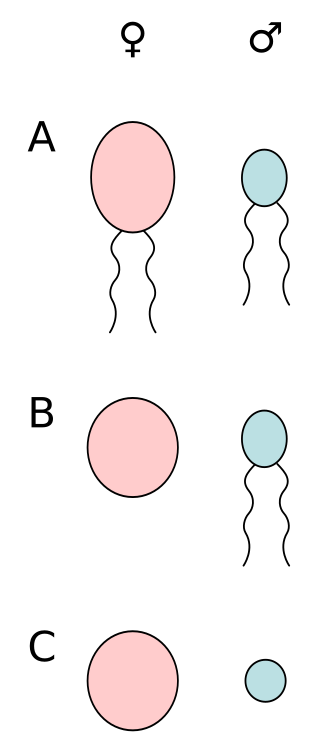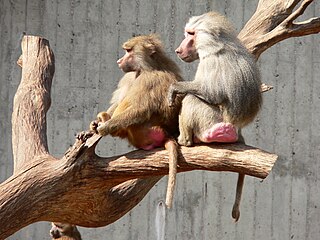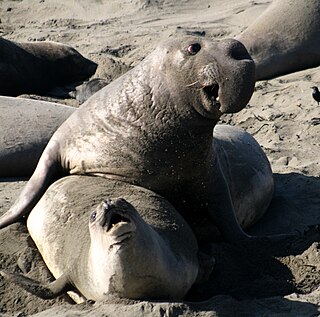Related Research Articles

Sexual selection is a mode of natural selection in which members of one biological sex choose mates of the other sex to mate with, and compete with members of the same sex for access to members of the opposite sex. These two forms of selection mean that some individuals have greater reproductive success than others within a population, for example because they are more attractive or prefer more attractive partners to produce offspring. Successful males benefit from frequent mating and monopolizing access to one or more fertile females. Females can maximise the return on the energy they invest in reproduction by selecting and mating with the best males.

Sex is the trait that determines whether a sexually reproducing organism produces male or female gametes. During sexual reproduction, a male and a female gamete fuse to form a zygote, which develops into an offspring that inherits traits from each parent. By convention, organisms that produce smaller, more mobile gametes are called male, while organisms that produce produce larger, non-mobile gametes are called female. An organism that produces both types of gamete is hermaphrodite.

Charadriiformes is a diverse order of small to medium-large birds. It includes about 390 species and has members in all parts of the world. Most charadriiform birds live near water and eat invertebrates or other small animals; however, some are pelagic (seabirds), others frequent deserts, and a few are found in dense forest. Members of this group can also collectively be referred to as shorebirds.

Sexual dimorphism is the condition where sexes of the same species exhibit different morphological characteristics, particularly characteristics not directly involved in reproduction. The condition occurs in most dioecious species, which consist of most animals and some plants. Differences may include secondary sex characteristics, size, weight, color, markings, or behavioral or cognitive traits. Male-male reproductive competition has evolved a diverse array of sexually dimorphic traits. Aggressive utility traits such as "battle" teeth and blunt heads reinforced as battering rams are used as weapons in aggressive interactions between rivals. Passive displays such as ornamental feathering or song-calling have also evolved mainly through sexual selection. These differences may be subtle or exaggerated and may be subjected to sexual selection and natural selection. The opposite of dimorphism is monomorphism, when both biological sexes are phenotypically indistinguishable from each other.

Waders or shorebirds are birds of the order Charadriiformes commonly found wading along shorelines and mudflats in order to forage for food crawling or burrowing in the mud and sand, usually small arthropods such as aquatic insects or crustaceans. The term "wader" is used in Europe, while "shorebird" is used in North America, where "wader" may be used instead to refer to long-legged wading birds such as storks and herons.
A mating system is a way in which a group is structured in relation to sexual behaviour. The precise meaning depends upon the context. With respect to animals, the term describes which males and females mate under which circumstances. Recognised systems include monogamy, polygamy, and promiscuity, all of which lead to different mate choice outcomes and thus these systems affect how sexual selection works in the species which practice them. In plants, the term refers to the degree and circumstances of outcrossing. In human sociobiology, the terms have been extended to encompass the formation of relationships such as marriage.

Anisogamy is a form of sexual reproduction that involves the union or fusion of two gametes that differ in size and/or form. The smaller gamete is male, a sperm cell, whereas the larger gamete is female, typically an egg cell. Anisogamy is predominant among multicellular organisms. In both plants and animals gamete size difference is the fundamental difference between females and males.

Allometry is the study of the relationship of body size to shape, anatomy, physiology and behaviour, first outlined by Otto Snell in 1892, by D'Arcy Thompson in 1917 in On Growth and Form and by Julian Huxley in 1932.

Bernhard Rensch was a German evolutionary biologist and ornithologist who did field work in Indonesia and India. Starting his scientific career with pro-Lamarckian views, he shifted to selectionism and became one of the architects of the modern synthesis in evolutionary biology, which he popularised in Germany. Besides his work on how environmental factors influenced the evolution of geographically isolated populations and on evolution above the species level, which contributed to the modern synthesis, he also worked extensively in the area of animal behavior (ethology) and on philosophical aspects of biological science. His education and scientific work were interrupted by service in the German military during both World War I and World War II.
Monogamous pairing in animals refers to the natural history of mating systems in which species pair bond to raise offspring. This is associated, usually implicitly, with sexual monogamy.

The Neriidae are a family of true flies (Diptera) closely related to the Micropezidae. Some species are known as cactus flies, while others have been called banana stalk flies and the family was earlier treated as subfamily of the Micropezidae which are often called stilt-legged flies. Neriids differ from micropezids in having no significant reduction of the fore legs. Neriids breed in rotting vegetation, such as decaying tree bark or rotting fruit. About 100 species are placed in 19 genera. Neriidae are found mainly in tropical regions, but two North American genera occur, each with one species, and one species of Telostylinus occurs in temperate regions of eastern Australia.

Sexual dimorphism describes the morphological, physiological, and behavioral differences between males and females of the same species. Most primates are sexually dimorphic for different biological characteristics, such as body size, canine tooth size, craniofacial structure, skeletal dimensions, pelage color and markings, and vocalization. However, such sex differences are primarily limited to the anthropoid primates; most of the strepsirrhine primates and tarsiers are monomorphic.

Sexual selection in humans concerns the concept of sexual selection, introduced by Charles Darwin as an element of his theory of natural selection, as it affects humans. Sexual selection is a biological way one sex chooses a mate for the best reproductive success. Most compete with others of the same sex for the best mate to contribute their genome for future generations. This has shaped human evolution for many years, but reasons why humans choose their mates are not fully understood. Sexual selection is quite different in non-human animals than humans as they feel more of the evolutionary pressures to reproduce and can easily reject a mate. The role of sexual selection in human evolution has not been firmly established although neoteny has been cited as being caused by human sexual selection. It has been suggested that sexual selection played a part in the evolution of the anatomically modern human brain, i.e. the structures responsible for social intelligence underwent positive selection as a sexual ornamentation to be used in courtship rather than for survival itself, and that it has developed in ways outlined by Ronald Fisher in the Fisherian runaway model. Fisher also stated that the development of sexual selection was "more favourable" in humans.

Sexual selection in mammals is a process the study of which started with Charles Darwin's observations concerning sexual selection, including sexual selection in humans, and in other mammals, consisting of male–male competition and mate choice that mold the development of future phenotypes in a population for a given species.

Sexual selection in amphibians involves sexual selection processes in amphibians, including frogs, salamanders and newts. Prolonged breeders, the majority of frog species, have breeding seasons at regular intervals where male-male competition occurs with males arriving at the waters edge first in large number and producing a wide range of vocalizations, with variations in depth of calls the speed of calls and other complex behaviours to attract mates. The fittest males will have the deepest croaks and the best territories, with females making their mate choices at least partly based on the males depth of croaking. This has led to sexual dimorphism, with females being larger than males in 90% of species, males in 10% and males fighting for groups of females.
Fecundity selection, also known as fertility selection, is the fitness advantage resulting from selection on traits that increases the number of offspring. Charles Darwin formulated the theory of fecundity selection between 1871 and 1874 to explain the widespread evolution of female-biased sexual size dimorphism (SSD), where females were larger than males.

A biological rule or biological law is a generalized law, principle, or rule of thumb formulated to describe patterns observed in living organisms. Biological rules and laws are often developed as succinct, broadly applicable ways to explain complex phenomena or salient observations about the ecology and biogeographical distributions of plant and animal species around the world, though they have been proposed for or extended to all types of organisms. Many of these regularities of ecology and biogeography are named after the biologists who first described them.

Harrison's rule is an observation in evolutionary biology by Launcelot Harrison which states that in comparisons across closely related species, host and parasite body sizes tend to covary positively.

Tamás Székely is a Hungarian evolutionary biologist and conservationist. He is the Professor of Biodiversity at the University of Bath and he holds an Honorary Professor position at the University of Debrecen, Hungary. He is also the Director of the Debrecen Biodiversity Centre. His 1999 article, Brood Desertion in Kentish Plover, laid the groundwork for the demographic hypothesis of sex roles' origin, demonstrating the social environment's influence on parental care dynamics. Székely has won multiple academic and conservation awards.

Sexual dimorphism is the condition where sexes of the same species exhibit different morphological characteristics, particularly characteristics not directly involved in reproduction. Sexual dimorphism in carnivorans, in which males are larger than females, is common among carnivorans. Sexual selection is frequently cited as the cause of the intraspecific divergence in body proportions and craniomandibular morphology between the sexes within the Carnivora order. It is anticipated that animals with polygynous mating systems and high levels of territoriality and solitary behavior will exhibit the highest levels of sexual size dimorphism. Pinnipeds offer an illustration for this.
References
- ↑ Rensch, B. (1950). "Die Abhängigkeit der relativen Sexualdifferenz von der Körpergrösse". Bonner Zoologische Beiträge. 1: 58–69.
- 1 2 Dale, James; Dunn, Peter O.; Figuerola, Jordi; Lislevand, Terje; Székely, Tamás; Whittingham, Linda A. (2007-12-07). "Sexual selection explains Rensch's rule of allometry for sexual size dimorphism". Proceedings of the Royal Society of London B: Biological Sciences. 274 (1628): 2971–2979. doi:10.1098/rspb.2007.1043. ISSN 0962-8452. PMC 2211517 . PMID 17878139.
- ↑ Blanckenhorn, Wolf; Dixon, A (2007). "Proximate Causes of Rensch's Rule: Does Sexual Size Dimorphism in Arthropods Result from Differences in Development Time?". The American Naturalist. University of Zurich. 169 (2): 245–257. doi:10.1086/510597. PMID 17211807. S2CID 19831154.
- ↑ Székely, Tamás; Freckleton, Robert P.; Reynolds, John D. (2004-08-17). "Sexual selection explains Rensch's rule of size dimorphism in shorebirds". Proceedings of the National Academy of Sciences of the United States of America. 101 (33): 12224–12227. Bibcode:2004PNAS..10112224S. doi: 10.1073/pnas.0404503101 . ISSN 0027-8424. PMC 514460 . PMID 15304645.
- ↑ Lengkeek, W.; Didderen, K.; Côté, I. M.; van der Zee, E. M.; Snoek, R. C.; Reynolds, J. D. (2008-10-01). "Plasticity in sexual size dimorphism and Rensch's rule in Mediterranean blennies (Blenniidae)". Canadian Journal of Zoology. 86 (10): 1173–1178. doi:10.1139/z08-103. ISSN 0008-4301.
- ↑ Fairbairn, D.J. (1997). "Allometry for Sexual Size Dimorphism: Pattern and Process in the Coevolution of Body Size in Males and Females". Annu. Rev. Ecol. Syst. 28 (1): 659–687. doi:10.1146/annurev.ecolsys.28.1.659.
- ↑ Piross, I.S.; Harnos, A.; Rozsa, L. (2019). "Rensch's rule in avian lice: contradictory allometric trends for sexual size dimorphism". Scientific Reports. 9 (1): 7908. Bibcode:2019NatSR...9.7908P. doi: 10.1038/s41598-019-44370-5 . PMC 6536520 . PMID 31133727.
